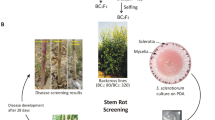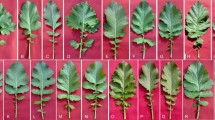Abstract
Brassica crops suffer heavily from sclerotinia stem rot which is caused by the necrotrophic fungal pathogen Sclerotinia sclerotiorum. A wild B. oleracea accession, C01 (B. incana), was identified to have good resistance to S. sclerotiorum, while B. rapa was highly susceptible. In order to improve the resistance level of B. rapa, a haploid was generated from a hybridization between a B. rapa accession 6Y733 and C01, where the major resistance quantitative trait loci (QTL) have been identified from chromosome C09. Molecular-assisted selection and resistance evaluation were performed in the backcross progenies with 6Y733 as the recurrent parent. Among 17 BC1F1 plants, one individual with the highest resistance level (1.2- and 1.7-fold higher resistance than 6Y733 in leaf and stem, respectively) and carrying resistance QTL was selected to develop BC2F1. One resistant BC2F1 plant carrying 20 chromosomes and resistance loci, and having similar morphology and fertility to 6Y733, was selected from 254 BC2F1 genotypes and further self-pollinated, resulting in 145 BC2F2 individual genotypes. One individual carrying 20 chromosomes and with good fertility (98.6 %) exhibited a significant higher resistance level than the parental B. rapa line (1.4- and 1.7-fold for leaf and stem resistance, respectively). Our data suggest that it is an effective strategy to transfer sclerotinia resistance from B. oleracea into B. rapa by using a haploid strategy which could prompt the genetic exchange of the A and C genomes.




Similar content being viewed by others
References
Boland GJ, Hall R (1994) Index of host plants of Sclerotinia sclerotiorum. Can J Plant Pathol 16:93–108
Chalhoub B et al (2014) Early allopolyploid evolution in the post-Neolithic Brassica napus oilseed genome. Science. doi:10.1126/science.1253435
Cheung F, Trick M, Drou N, Lim YP, Park JY, Kwon SJ, Kim JA, Scott R, Pires JC, Paterson AH, Town C, Bancroft I (2009) Comparative analysis between homoeologous genome segments of Brassica napus and its progenitor species reveals extensive sequence-level divergence. Plant Cell 21:1912–1928
Cui C, Ge X, Gautam M, Kang L, Li Z (2012) Cytoplasmic and genomic effects on meiotic pairing in Brassica hybrids and allotetraploids from pair crosses of three cultivated diploids. Genetics 191:725–738
Diederichsen E, Frauen M, Linders EGA, Hatakeyama K, Hirai M (2009) Status and perspectives of clubroot resistance breeding in crucifer crops. J Plant Growth Regul 28:265–281
Inaba R, Nishio T (2002) Phylogenetic analysis of Brassiceae based on the nucleotide sequences of the S-locus related gene, SLR1. Theor Appl Genet 105:1159–1165
Leflon F, Eber J, Letanneur L, Chelysheva O, Coriton O, Huteau C, Ryder G, Barker E, Jenczewski A, Chèvre A (2006) Pairing and recombination at meiosis of Brassica rapa (AA) × Brassica napus (AACC) hybrids. Theor Appl Genet 113:1467–1480
Liu S et al (2014) The Brassica oleracea genome reveals the asymmetrical evolution of polyploid genomes. Nat Commun. doi:10.1038/ncomms4930
Mei J, Qian L, Disi JO, Yang X, Li Q, Li J, Frauen M, Cai D, Qian W (2011) Identification of resistant sources against Sclerotinia sclerotiorum in Brassica crops with emphasis on B. oleracea. Euphytica 177:393–400
Mei J, Wei D, Disi J, Ding Y, Liu Y, Qian W (2012) Screening resistance against Sclerotinia sclerotiorum in Brassica crops with use of detached stem assay under controlled environment. Eur J Plant Pathol 134:599–604
Mei J, Ding Y, Lu K, Wei D, Liu Y, Disi J, Li J, Liu L, Liu S, McKay J, Qian W (2013) Identification of genomic regions involved in resistance against Sclerotinia sclerotiorum from wild Brassica oleracea. Theor Appl Genet 126:549–556
Mei J, Liu Y, Wei D, Wittkop B, Ding Y, Li Q, Li J, Wan H, Li Z, Ge X, Frauen M, Snowdon R, Qian W, Friedt W (2015) Transfer of sclerotinia resistance from wild relative of Brassica oleracea into Brassica napus using a hexaploidy step. Theor Appl Genet 128:639–644
SAS Institute (1992) SAS technical report. SAS statistics software: changes and enhancements. Release 6.07
Schranz M, Lysak M, Mitchell-Olds T (2006) The ABC’s of comparative genomics in the Brassicaceae: building blocks of crucifer genomes. Trends Plant Sci 11:535–542
Song K, Osborn T (1992) Polyphyletic origins of Brasscia napus: new evidence based on organelle and nuclear RFLP analyses. Genome 35:992–1001
Song K, Osborn T, Williams P (1988) Brassica taxonomy based on nuclear restriction fragment length polymorphisms (RFLPs) 1. Genome evolution of diploid and amphidiploid species. Theor Appl Genet 75:784–794
Song K, Osborn T, Williams P (1990) Brassica taxonomy based on nuclear restriction fragment length polymorphisms (RFLPs) 3. Genome relationships in Brassica and related genera and the origin of B. oleracea and B. rapa (syn. campestris). Theor Appl Genet 779:497–506
Szadkowski E, Eber F, Huteau V, Lodé M, Huneau C, Belcram H, Coriton O, Manzanares M, Delourme R, King G, Chalhoub B, Jenczewski E, Chèvre A (2010) The first meiosis of resynthesized Brassica napus, a genome blender. New Phytol 186:102–112
Wen J, Tu JX, Li ZY, Fu TD, Ma CZ, Shen JX (2008) Improving ovary and embryo culture techniques for efficient resynthesis of Brassica napus from reciprocal crosses between yellow-seeded diploids B. rapa and B. oleracea. Euphytica 162:81–89
Yu B, Liu P, Hong D, He Q, Yang G (2010) Improvement of sclerotinia resistance of a Polima CMS restorer line of rapeseed via phenotypic selection, marker-assisted background selection and microspore culture. Plant Breed 129:39–44
Yu J, Zhao M, Wang X, Tong C, Huang S, Tehrim S, Liu Y, Hua W, Liu S (2013) Bolbase: a comprehensive genomics database for Brassica oleracea. BMC Genom 14:664
Zhao J, Meng J (2003) Genetic analysis of loci associated with partial resistance to Sclerotinia sclerotiorum in rapeseed (Brassica napus L.). Theor Appl Genet 106:759–764
Zhao J, Peltier AJ, Meng J, Osborn TC, Grau CR (2004) Evaluation of sclerotinia stem rot resistance in oilseed Brassica napus using a petiole inoculation technique under greenhouse conditions. Plant Dis 88:1033–1039
Zhao JW, Udall JA, Quijada PA, Grau CR, Meng JL, Osborn TC (2006) Quantitative trait loci for resistance to Sclerotinia sclerotiorum and its association with a homeologous non-reciprocal transposition in Brassica napus L. Theor Appl Genet 112:509–516
Acknowledgments
This study was financially supported by the 973 Program (2015CB150201), Key Projects in National Science and Technology (2014BAD01B07), National Nature Science Foundation of China (31401411 and 31171585), CSTC2012ggB80008 and CSTC2014yykfA80008.
Author information
Authors and Affiliations
Corresponding author
Rights and permissions
About this article
Cite this article
Ding, Y., Mei, J., Liu, Y. et al. Transfer of sclerotinia stem rot resistance from wild Brassica oleracea into B. rapa . Mol Breeding 35, 225 (2015). https://doi.org/10.1007/s11032-015-0392-4
Received:
Accepted:
Published:
DOI: https://doi.org/10.1007/s11032-015-0392-4




